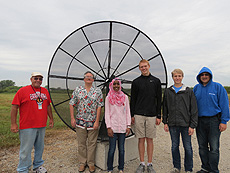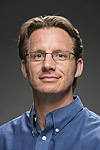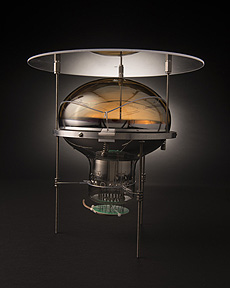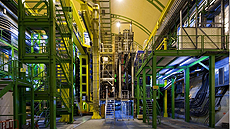QuarkNet students launch 8-foot radio telescope
 |
This group is building an 8-foot radio telescope as part of the QuarkNet program at Fermilab. From left: Edward Dijak (PPD), Chris Stoughton (PPD), Saniya Qadir (Wheaton North HS), Jake Johanik (home school), Maciej Mleczko (Wheaton Warrenville South High School) and George Dzuricsko (WDRS). Not pictured: Ben Sawyer (teacher at Wheaton Academy) and Albert Stebbins (PPD). Photo: Lauren Craig, WDRS |
"I've figured it out, we can do it!"
Jake Johanik's excitement is directed to the QuarkNet Radio Telescope Group upon locating, after much research, a possible antenna for the radio telescope project.
The QuarkNet Radio Telescope, or QRT, is an 8-foot telescope that currently stands on the rocky grounds of DZero's outback building. Under the guidance of Fermilab scientist Chris Stoughton, three of us are building the QRT as part of the Fermilab-University of Chicago QuarkNet research program. Johanik, Maciej Mleczko and I — all high school students — plan to use the telescope to map celestial objects and measure the rotation of our Milky Way galaxy.
Our immediate goal for this six-week project is to see the 21-centimeter hydrogen line — a signal that we've successfully detected the neutral hydrogen that makes up cold interstellar gases. Our grander aim is create a hands-on manual for high school teachers to provide instructions on both building the radio telescope and interpreting the data. We hope that teachers can then easily implement radio telescopes at their high schools, helping to build a network of people gathering data from radio telescopes to make even stronger measurements of our universe.
"I think this project could grow," said Fermilab scientist Albert Stebbins, who assisted us. "We can use a network of the radio telescopes to look for radio transients. The specific 21-centimeter line is just the first stage."
The 21-centimeter line would appear as a signal in our plot, one that arises from the shift of an electron in a hydrogen atom dropping to a lower energy level.
"We would also like to see the Doppler shift from the Milky Way," Johanik said. The Doppler shift shows us if a galaxy or star is moving toward or away from us.
The QRT is mounted on an aluminum stand and a 3-foot-long cement block. A parabolic dish concentrates the incoming radio waves onto an antenna, which sends the signal to an amplifier. The amplified signal is then processed to a computer on site and analyzed.
We began collecting data from the radio telescope last week. The data will be saved onto a file for easy access off site.
Mleczko said that one of the best parts about QuarkNet is giving students and teachers a chance to work together as colleagues and making progress together.
The QRT will be permanently installed outside the Lederman Science Center. It may even support the very kind of research scientists conduct at Fermilab.
"There could be long-term connections to the 21-centimeter research. From a cosmological point of view, a 21-centimeter survey could be a probe to dark energy and dark matter," Stoughton said. "Just some food for thought!"
—Saniya Qadir, Wheaton North High School
| 


